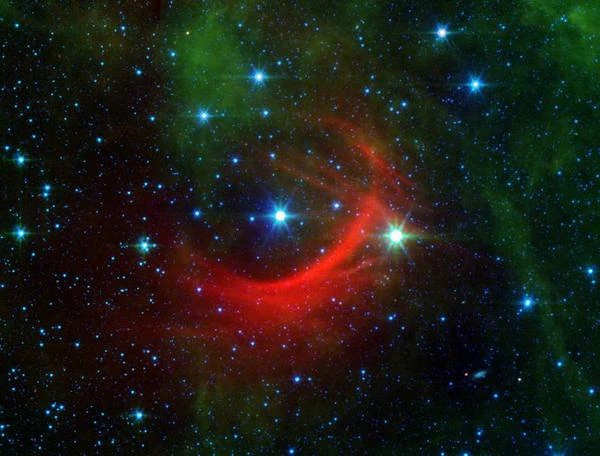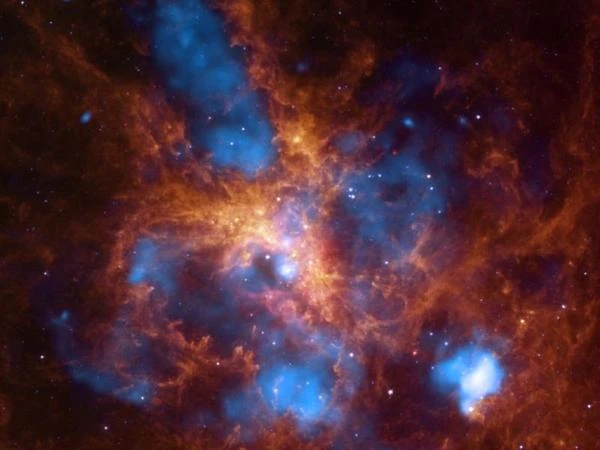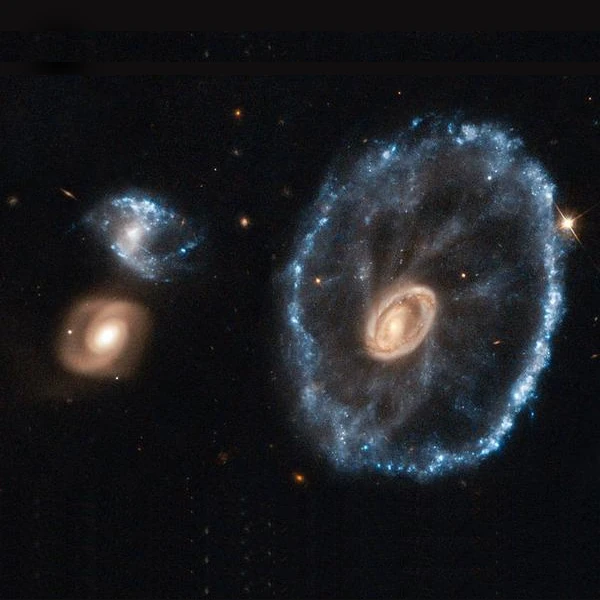
Cosmic shock waves are compression fronts of matter and magnetic fields generated by energetic events such as supernova explosions, galaxy cluster collisions, or black hole jets. These waves carry energy over enormous distances and actively participate in the large-scale structuring of the universe.
When a massive star moves at high speed through the interstellar medium (ISM), it can exceed the speed of sound in the surrounding gas. This also creates a "bow shock" (arc-shaped shock wave in front of the star). The star acts like a "boat" in the ISM, pushing gas and dust.
For Kappa Cassiopeiae, a hypermassive blue supergiant, the high-speed movement (often several tens of km/s) creates a compression of the interstellar gas that becomes visible in IR or radio due to the emission of dust grains heated by stellar radiation and particles accelerated by the shock wave.
The front of a shock wave is characterized by a sudden change in density, pressure, and velocity. In an astrophysical medium, the wave speed can reach several thousand km/s, depending on the density of the medium and the energy of the event. The propagation follows hydrodynamic and magnetohydrodynamic (MHD) equations and can accelerate particles to relativistic energies.
Shock waves play a crucial role in the formation of galaxy clusters, cosmic filaments, and the amplification of magnetic fields. They also promote the condensation of intergalactic gas and can trigger star formation in certain regions.
| Name of the Shock Wave | Type of Source | Distance | Estimated Speed (km/s) | Observation |
|---|---|---|---|---|
| Bullet Cluster | Cluster Collision | 1,000 Mpc | 4,500 | Chandra, Hubble |
| Abell 3667 | Galaxy Cluster | 220 Mpc | 2,500 | Radio VLA |
| Supernova SN 1006 | Supernova | 2.2 kpc | 5,000 | Chandra, XMM-Newton |
| Perseus Cluster | Galaxy Cluster | 78 Mpc | 1,500 | Chandra |
| Tarantula Shock Wave | Massive Clusters and Supernovae | 50 kpc | 1,000–2,000 | Hubble, Chandra, ALMA |
| Kappa Cassiopeiae | Massive Moving Star | 0.4 pc | 30–40 | IR – Spitzer, WISE |
| Zeta Ophiuchi | Massive Moving Star | 0.16 pc | 24 | IR – Spitzer |
| BD+43°3654 | Massive Moving Star | 0.5 pc | 60 | IR – Spitzer |
| AE Aurigae | Massive Moving Star | 0.2 pc | 100 | IR – Spitzer, Hubble |
| Mu Columbae | Massive Moving Star | 0.15 pc | 100 | IR – Spitzer |
Source: Chandra X-ray Observatory, ESO – European Southern Observatory, and Spitzer Space Telescope.

The Tarantula Nebula, located in the Large Magellanic Cloud about 50 kpc from Earth, is one of the most active star-forming regions in the galactic neighborhood. It hosts the massive star cluster R136, composed of OB stars and extremely luminous supergiants.
The intense activity of these stars, combined with recent supernova explosions, generates a giant shock wave that propagates through the surrounding interstellar medium. This wave compresses and heats the gas, promoting emission in IR, X-ray, and radio. Its speed is estimated between 1,000 and 2,000 km/s, and its structure can extend over several tens of parsecs.
N.B.:
The Tarantula shock wave illustrates how a very active environment can generate large-scale compression fronts, comparable, on a smaller scale, to shock waves in galaxy clusters.

The Cartwheel Galaxy, located about 500 million light-years away in the Sculptor constellation, has a remarkable ring-shaped morphology, a consequence of a head-on impact with a smaller compact galaxy. This event generated a radial shock wave that propagates through the galaxy's disk at an estimated speed of 100–200 km/s.
This shock wave concentrates the interstellar gas and triggers intense star formation along the ring, visible in optical and X-ray light. The distribution of these HII regions precisely follows the propagation of the density wave.
From a physical point of view, the wave acts as a compression wave of the interstellar medium, similar to density fronts in spiral galaxies, but here amplified by the frontal gravitational impact. The observed dynamics allow the study of gas behavior under extreme conditions and the testing of large-scale density wave propagation models.
N.B.:
The bright ring of the Cartwheel Galaxy is the direct result of the shock wave propagated in the galactic disk, showing gravitational interaction as a driver of large-scale star formation.